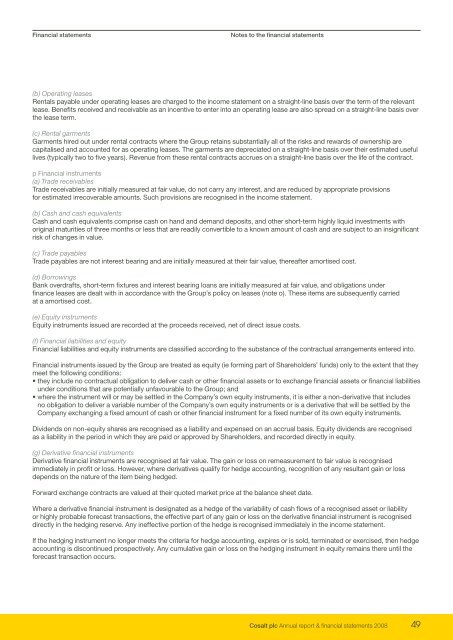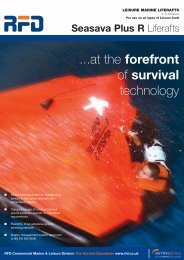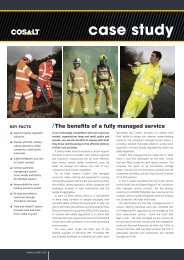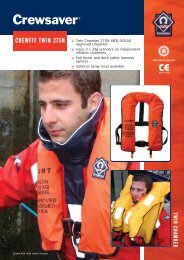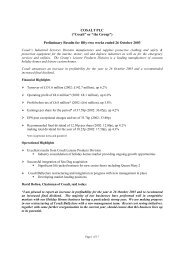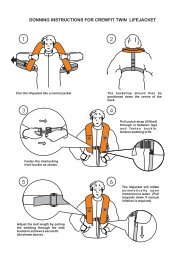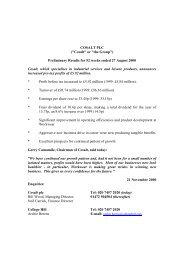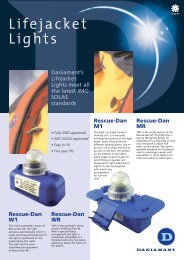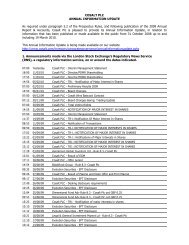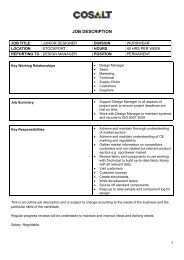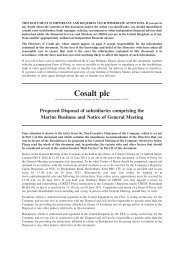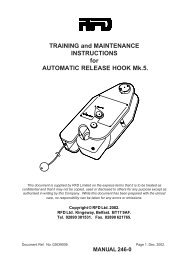Cosalt plc Annual report & financial statements 2008
Cosalt plc Annual report & financial statements 2008
Cosalt plc Annual report & financial statements 2008
You also want an ePaper? Increase the reach of your titles
YUMPU automatically turns print PDFs into web optimized ePapers that Google loves.
Financial <strong>statements</strong><br />
Notes to the <strong>financial</strong> <strong>statements</strong><br />
(b) Operating leases<br />
Rentals payable under operating leases are charged to the income statement on a straight-line basis over the term of the relevant<br />
lease. Benefits received and receivable as an incentive to enter into an operating lease are also spread on a straight-line basis over<br />
the lease term.<br />
(c) Rental garments<br />
Garments hired out under rental contracts where the Group retains substantially all of the risks and rewards of ownership are<br />
capitalised and accounted for as operating leases. The garments are depreciated on a straight-line basis over their estimated useful<br />
lives (typically two to five years). Revenue from these rental contracts accrues on a straight-line basis over the life of the contract.<br />
p Financial instruments<br />
(a) Trade receivables<br />
Trade receivables are initially measured at fair value, do not carry any interest, and are reduced by appropriate provisions<br />
for estimated irrecoverable amounts. Such provisions are recognised in the income statement.<br />
(b) Cash and cash equivalents<br />
Cash and cash equivalents comprise cash on hand and demand deposits, and other short-term highly liquid investments with<br />
original maturities of three months or less that are readily convertible to a known amount of cash and are subject to an insignificant<br />
risk of changes in value.<br />
(c) Trade payables<br />
Trade payables are not interest bearing and are initially measured at their fair value, thereafter amortised cost.<br />
(d) Borrowings<br />
Bank overdrafts, short-term fixtures and interest bearing loans are initially measured at fair value, and obligations under<br />
finance leases are dealt with in accordance with the Group’s policy on leases (note o). These items are subsequently carried<br />
at a amortised cost.<br />
(e) Equity instruments<br />
Equity instruments issued are recorded at the proceeds received, net of direct issue costs.<br />
(f) Financial liabilities and equity<br />
Financial liabilities and equity instruments are classified according to the substance of the contractual arrangements entered into.<br />
Financial instruments issued by the Group are treated as equity (ie forming part of Shareholders’ funds) only to the extent that they<br />
meet the following conditions:<br />
• they include no contractual obligation to deliver cash or other <strong>financial</strong> assets or to exchange <strong>financial</strong> assets or <strong>financial</strong> liabilities<br />
under conditions that are potentially unfavourable to the Group; and<br />
• where the instrument will or may be settled in the Company’s own equity instruments, it is either a non-derivative that includes<br />
no obligation to deliver a variable number of the Company’s own equity instruments or is a derivative that will be settled by the<br />
Company exchanging a fixed amount of cash or other <strong>financial</strong> instrument for a fixed number of its own equity instruments.<br />
Dividends on non-equity shares are recognised as a liability and expensed on an accrual basis. Equity dividends are recognised<br />
as a liability in the period in which they are paid or approved by Shareholders, and recorded directly in equity.<br />
(g) Derivative <strong>financial</strong> instruments<br />
Derivative <strong>financial</strong> instruments are recognised at fair value. The gain or loss on remeasurement to fair value is recognised<br />
immediately in profit or loss. However, where derivatives qualify for hedge accounting, recognition of any resultant gain or loss<br />
depends on the nature of the item being hedged.<br />
Forward exchange contracts are valued at their quoted market price at the balance sheet date.<br />
Where a derivative <strong>financial</strong> instrument is designated as a hedge of the variability of cash flows of a recognised asset or liability<br />
or highly probable forecast transactions, the effective part of any gain or loss on the derivative <strong>financial</strong> instrument is recognised<br />
directly in the hedging reserve. Any ineffective portion of the hedge is recognised immediately in the income statement.<br />
If the hedging instrument no longer meets the criteria for hedge accounting, expires or is sold, terminated or exercised, then hedge<br />
accounting is discontinued prospectively. Any cumulative gain or loss on the hedging instrument in equity remains there until the<br />
forecast transaction occurs.<br />
<strong>Cosalt</strong> <strong>plc</strong> <strong>Annual</strong> <strong>report</strong> & <strong>financial</strong> <strong>statements</strong> <strong>2008</strong><br />
49


